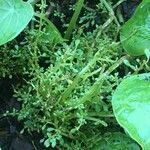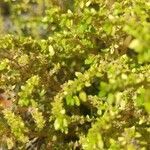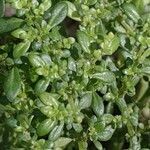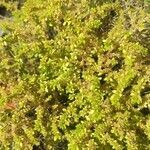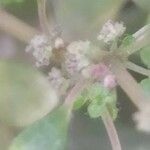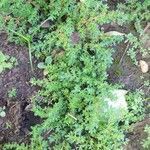Glabrous, succulent, much-branched herb, up to 30 cm. high, variable in size and habit; leaves usually crowded throughout the length of the branches, entire, succulent, those of a pair unequal, the larger prevailingly obovate, up to 1 cm. long, petiolate, obtuse or subacute, tapering at base, the smaller orbicular or obovate-orbicular, rarely more than 3 mm. long, sessile or short-petioled; cystoliths linear, transverse across the leaf-blade; plants monoecious, rarely dioecious, the flower clusters very small, sessile or nearly so; achenes ovate, about 0.3 mm. long. Throughout the American tropics, up to 2500 m. altitude, occurring in a variety of habitats, as in crevices of stone walls or pavements, on mossy roots or rocks, or on the forest floor; often cultivated as a border plant or in pots.
Herb up to 30 cm high, with branched stems, usually monoecious. Stems 0.5-5 mm thick, glabrous. Leaves of a pair unequal; stipules lacking (?); petiole up to 0.4 cm long; blade papyraceous, broadly obovate to narrowly obovate, elliptic to narrowly elliptic or ovate to broadly ovate to suborbicular, 0.1-1 x 0.1-0.5 cm, apex rounded, obtuse or subacute, base attenuate to acute or obtuse to rounded, margin entire, both surfaces glabrous; secondary veins lacking. Inflorescences in the leaf axils, subsessile or up to 0.2 cm long pedunculate, sparsely branched, with up to ca. 15, subsessile flowers. Staminate flowers: tepals ca. 0.3 mm long. Pistillate flowers: tepals 0.1-0.3 mm long. Achene ca. 0.3 mm long.
Low or procumbent to ± prostrate herb to 40 cm high, annual to short-lived perennial, monoecious, much-branched, somewhat succulent, glabrous without stinging hairs. Leaves: lamina elliptic to obovate, entire, subacute to obtuse apex, cuneate and usually oblique at base, 1.5–6 mm long, 2–5 mm wide, one leaf of each pair smaller than the other; petiole 1–2.5 mm long. Inflorescence few-flowered, globose. Male flowers 4-merous. Female flowers with 1 perianth lobe larger than the other 2 and cucullate, almost 1 mm long, enclosing the developing achene. Achenes ovoid, slightly laterally compressed, c. 0.4 mm long, brown, enclosed in persistent perianth.
Herbs , annual or short-lived perennial, 0.3-2 dm. Stems 10-40-branched, erect. Leaf blades spatulate to obovate, paired blades unequal, the larger 3-10 × 1.5-5.5 mm, the smaller 1.5-4 × 0.7-2 mm, margins entire. Inflorescences crowded. Flowers ca. 0.5 mm across. Achenes uniformly light brown, slightly compressed, ovoid-cylindric, ca. 0.5(-1.1) × 0.3 mm, smooth.
A herb that grows each year from seed. It is a creeping plant. The stems are branched. The leaves are very small and fleshy. They are round and 2-3 mm across. The flowers are white and of one sex. They form groups in the axils of the leaves. There are only a few flowers. The fruit is small and has one seed.
